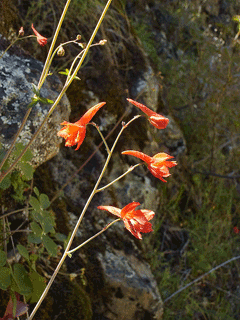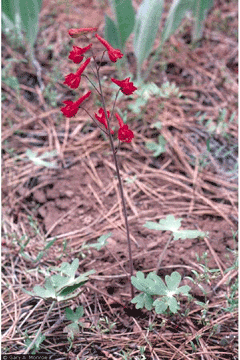 |
|
http://www.flickr.com/photos/11563230@N04 |
 |
| Gary A. Monroe @ USDA-NRCS PLANTS Database |
Translate this page:
Summary
Bloom Color: Orange.
Main Bloom Time: Early summer, Late summer, Late spring, Mid summer. Form: Irregular or sprawling, Upright or erect.
Physical Characteristics

 Delphinium nudicaule is a PERENNIAL growing to 0.3 m (1ft) by 0.3 m (1ft in) at a medium rate.
Delphinium nudicaule is a PERENNIAL growing to 0.3 m (1ft) by 0.3 m (1ft in) at a medium rate.
See above for USDA hardiness. It is hardy to UK zone 8. It is in flower from June to August. The species is hermaphrodite (has both male and female organs).
Suitable for: light (sandy), medium (loamy) and heavy (clay) soils and prefers well-drained soil. Suitable pH: mildly acid, neutral and basic (mildly alkaline) soils. It cannot grow in the shade. It prefers moist soil.
UK Hardiness Map
US Hardiness Map
Synonyms
Plant Habitats
Woodland Garden Sunny Edge; Cultivated Beds;
Edible Uses
References More on Edible Uses
Medicinal Uses
Plants For A Future can not take any responsibility for any adverse effects from the use of plants. Always seek advice from a professional before using a plant medicinally.
Narcotic
The root is considered by some native North American Indians to be highly narcotic[213, 257].
References More on Medicinal Uses
The Bookshop: Edible Plant Books
Our Latest books on Perennial Plants For Food Forests and Permaculture Gardens in paperback or digital formats.

Edible Tropical Plants
Food Forest Plants for Hotter Conditions: 250+ Plants For Tropical Food Forests & Permaculture Gardens.
More

Edible Temperate Plants
Plants for Your Food Forest: 500 Plants for Temperate Food Forests & Permaculture Gardens.
More

More Books
PFAF have eight books available in paperback and digital formats. Browse the shop for more information.
Shop Now
Other Uses
A blue dye is obtained from the flowers[207]. An ink can be made from the dye[207]. A parasiticide is obtained from the leaves[172]. It is quite toxic and so is for external use only.
Special Uses
References More on Other Uses
Cultivation details
Landscape Uses:Border, Container, Foundation, Massing, Rock garden, Seashore, Specimen. Prefers a rich well-drained soil[111, 200]. Dislikes water-logged soils[200]. Requires an open sunny position[188]. Plants can flower in their first year from spring-sown seed, they are reliably perennial in their native environment, but often die overwinter in most parts of Britain[200]. A greedy plant, inhibiting the growth of nearby plants, especially legumes[54]. Slugs and snails are very attracted to this plant[200]. Special Features: Attracts birds, Attractive foliage, North American native, All or parts of this plant are poisonous, Suitable for cut flowers, Suitable for dried flowers, Extended bloom season in Zones 9A and above.
References Carbon Farming Information and Carbon Sequestration Information
Temperature Converter
Type a value in the Celsius field to convert the value to Fahrenheit:
Fahrenheit:
The PFAF Bookshop
Plants For A Future have a number of books available in paperback and digital form. Book titles include Edible Plants, Edible Perennials, Edible Trees,Edible Shrubs, Woodland Gardening, and Temperate Food Forest Plants. Our new book is Food Forest Plants For Hotter Conditions (Tropical and Sub-Tropical).
Shop Now
Plant Propagation
Seed - sow March/April in a cold frame or May outdoors[111]. Keep moist and in a shady position until germination takes place[175]. The seed has a limited viability so it should be stored in a sealed container at about 3°c[200]. Temperatures above 15°c inhibit germination[175]. The seed usually germinates in 2 - 9 weeks at 15°c[175]. When they are large enough to handle, prick the seedlings out into individual pots and plant them out into their permanent positions in the summer. Cuttings of basal shoots in April/May, taken before they become hollow at the base, and planted in a cold frame[111]. Division in spring[111] or early autumn[200].
Other Names
If available other names are mentioned here
Native Range
NORTHERN AMERICA: United States (Oregon, California)
Weed Potential
Right plant wrong place. We are currently updating this section.
Please note that a plant may be invasive in one area but may not in your area so it's worth checking.
Conservation Status
IUCN Red List of Threatened Plants Status :

Growth: S = slow M = medium F = fast. Soil: L = light (sandy) M = medium H = heavy (clay). pH: A = acid N = neutral B = basic (alkaline). Shade: F = full shade S = semi-shade N = no shade. Moisture: D = dry M = Moist We = wet Wa = water.
Now available:
Food Forest Plants for Mediterranean Conditions
350+ Perennial Plants For Mediterranean and Drier Food Forests and Permaculture Gardens.
[Paperback and eBook]
This is the third in Plants For A Future's series of plant guides for food forests tailored to
specific climate zones. Following volumes on temperate and tropical ecosystems, this book focuses
on species suited to Mediterranean conditions—regions with hot, dry summers and cool, wet winters,
often facing the added challenge of climate change.
Read More
Expert comment
Author
Torr.&A.Gray.
Botanical References
71200
Links / References
For a list of references used on this page please go here
Readers comment
| Add a comment |
|
If you have important information about this plant that may help other users please add a comment or link below. Only comments or links that are felt to be directly relevant to a plant will be included. If you think a comment/link or information contained on this page is inaccurate or misleading we would welcome your feedback at [email protected]. If you have questions about a plant please use the Forum on this website as we do not have the resources to answer questions ourselves.
* Please note: the comments by website users are not necessarily those held by PFAF and may give misleading or inaccurate information.
To leave a comment please Register or login here All comments need to be approved so will not appear immediately.
|
Subject : Delphinium nudicaule
|
|
|
|